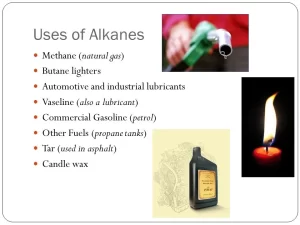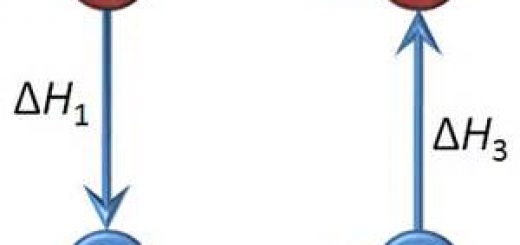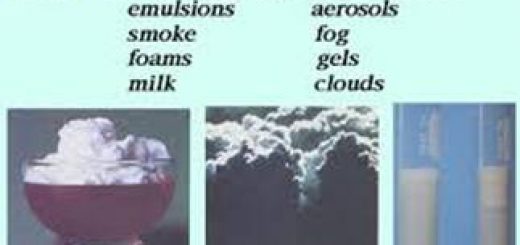Alkanes economic importance, uses, physical and chemical properties
Alkanes are used to prepare black carbon, water gas, alkyl halides, alcohols, and aldehydes, They are homologous series as each compound exceeds the previous one by (– CH2) group, They have a general molecular formula, the same chemical properties and graduated in physical properties, Liquid and gaseous alkanes are used as fuel.
Physical properties of Alkanes
The first four members of alkanes are gases at normal temperature, Methane can be used as fuel at homes, while the mixture of propane and butane is liquified and packed in cylinders, It is used as fuel (butagas), since propane is more volatile (less boiling point) than butane, so we find that the ratio of propane is much more in cold countries, while in warm countries the cylinders contain a larger ratio of butane.
Alkanes which contain (5: 17) carbon atoms are liquids such as gasoline and kerosine which are used as liquid fuel, The compounds that contain more than 17 carbon atoms are solids such as paraffin wax, with increasing number of carbon atoms (molecular mass) in alkane, The boiling point of alkanes will increases because as the molecular mass increases, the boiling point increases.
Alkanes are non-polar compounds and insoluble in water, but they are soluble in organic solvents, So the metals are covered by a heavy layer of alkanes like grease to protect them against rust and corrosion, The boiling point and melting point increase by increasing the number of C atoms.
Long-chain alkanes are found in kerosene, diesel, lubricating oils, and paraffin wax, The method used to separate alkanes from each other in petroleum oil is called fractional distillation, Fractional distillation is a method which is used to separate Alkanes from each other in petroleum ore.
Chemical properties of Alkanes
Alkanes are comparatively, inactive compounds because the carbon atoms in alkanes are combined by the strong sigma bonds, these bonds can’t be broken easily except under certain conditions such as burning, substitution, and thermal catalytic cracking.
Alkanes are chemically unreactive, they are neither affected by mineral acids at room temperature nor affected by oxidizing agents such as KMnO4 or K2Cr2O7, This is due to the presence of a sigma bond (σ) which is difficult to be broken.
Burning
All alkanes burn giving water vapour, carbon dioxide, and heat, these reactions are highly exothermic, which is why they are used as fuels.
CH4 (g) + 2 O2 (g) → CO2 (g) + 2H2O (l) + Heat
Substitution
Alkanes react with halogens (F2, Cl2, Br2) by heating up to 400°C or in the presence of indirect sunlight (Ultraviolet rays) in a series of substitution reactions, The difference in the products of halogenation of alkanes in the presence of ultraviolet rays because the product depends on the ratio between methane and halogen in reaction mixture, Substitution reaction is the type of reaction between methane and halogens in the presence of ultraviolet rays.
CH4 (g) + Cl2 (g) → CH3Cl (g) + HCl (g)
CH3Cl (g) + Cl2 (g) → CH2Cl2 (g) + HCl (g)
CH2Cl2 (g) + Cl2 (g) → CHCl3 (g) + HCl (g)
CHCl3 (g) + Cl2 (g) → CCl4 (g) + HCl (g)
In the case of direct sun rays (Elimination), the reaction is accompanied by an explosion.
CH4 (g) + 2Cl2 (g) → C(s) + 4 HCl (g)
Uses of halogenated derivations of alkanes
Chloroform CHCl3 was used for a long time as an anesthetic substance but its usage was stopped because the inaccurate estimation of the dose for each patient causes death, Halothane is used now as an anesthetic substance with safety and its formula is CHBrCl–CF3, 2-bromo-2-chloro-1,1,1 triflouro ethane, The compound 1,1,1 trichloro ethane is used in the dry cleaning.
Freons were used in air conditions and fridges, also as a rushed substance to liquid and perfumes and as a cleaner of electronic sets, Freons are considered as halogenated derivatives of alkanes that are composed of (C,F,Cl) as CF4 tetraflouro methane but the famous one is dichloro diflouro methane CF2Cl2, So freons contain (C,F,Cl).
Freons are used in large quantities due to their cheap price, easily to be liquified, odourless, non-poisonous, non-flammable, and non-corrosive for metals, However, Freons cause the decay of the ozone layer which protects the earth against the harmful effects of ultraviolet rays, So, there is an international agreement to prevent the usage of freons starting from 2020.
Thermal catalytic cracking
This process usually takes place during the refining of petroleum oil to convert the heavy long petroleum chains (less used) to the daily used lighter short chain products, this process takes place by heating the heavy petroleum products under high pressure and temperature in the presence of a catalyst to produce two kinds of products.
- Short-chain alkanes which are used with gasoline to fulfill permanent world needs such as car fuel.
- Short-chain alkenes such as ethene and propene which are used in many chemical industries such as the manufacture of polymers.
C8 H18 (l) → C4 H8 (g) + C4 H10 (g)
Thermal catalytic cracking (for octane only) is a process in which the long carbon chains are broken into shorter ones by the action of heat, pressure and catalysts.
Economic importance of alkanes
Alkanes are used to obtain finely divided carbon (black carbon) by thermal cracking, The black carbon is produced by heating methane to 1000° C in the absence of air, Black carbon is used in the manufacture of car tires, black painting, polishes, and printing ink.
CH4 (g) → C(s) + 2 H2 (g)
Alkanes are used to obtain water gas, water gas is a mixture of hydrogen and carbon monoxide which is used as a reducing agent or as a flammable fuel, Hydrogen gas formed by this reaction is used in several industries such as in the manufacture of ammonia gas, Water gas is used in medrix furance to reduce Fe2O3 to Fe.
H2O (l) + CH4 (g) → 3H2 (g) + CO (g)
Methane is used as fuel in houses but a mixture of propane and butane (liquid) is filled in cylinders and used as a fuel (Butagas) since propane is more volatile than butane, in cold countries, the ratio of propane is more, in warm countries, the cylinders contain a larger ratio of butane.
CH4 (g) + 2O2 (g) → CO2 (g) + 2H2O (l) + Heat
(Alkane) Methane is used as fuel in houses because it burns in the air giving CO2, H2O, and heat, The reaction is an exothermic reaction, so methane is used as a fuel, Alkanes are used to prepare a large number of important compounds as alkyl halides, alcohols, and aldehydes.
Alkanes are a group of hydrocarbons, organic compounds consisting only of hydrogen and carbon atoms. They are the simplest organic molecules and play a vital role in the global economy due to their various applications.
The most significant economic importance of alkanes lies in their use as fuels. Natural gas, methane (CH₄), is the primary component of natural gas and is used for heating, cooking, and electricity generation.
Liquefied petroleum gas (LPG), a mixture of propane (C₃H₈) and butane (C₄H₁₀), is commonly used in camping stoves and grills. It is a popular fuel for cooking and heating, particularly in areas without access to natural gas pipelines.
The simplest alkanes, methane (CH₄), ethane (C₂H₆), and propane (C₃H₈), are major components of natural gas and liquefied petroleum gas (LPG) commonly used for heating, cooking, and electricity generation. Branched-chain alkanes like octane (C₈H₁₈) are significant constituents of gasoline, powering vehicles.
Gasoline, a complex mixture of various alkanes with 5-10 carbon atoms, is the primary fuel for vehicles, and other gasoline-powered engines. Longer-chain alkanes are excellent lubricants due to their ability to reduce friction between moving parts. They are used in various motor oils, greases, and industrial lubricants.
Alkanes are essential raw materials for numerous industrial processes. They undergo various chemical reactions to produce numerous products, Various industrial chemicals, including alcohols, solvents, detergents, and refrigerants, are derived from alkanes through chemical processes, They have alkanes as precursors.
Alkanes with higher numbers of carbon atoms are used to make waxes, lubricants, and asphalt. Asphalt, a sticky, black mixture found in crude oil, is used in road construction.
Alkanes are valuable starting materials for the production of numerous chemicals through various processes like cracking, reforming, and isomerization. These processes transform alkanes into starting materials for plastics, detergents, synthetic fibers, and other industrial chemicals.
The economic importance of alkanes is undeniable. They provide us with fuel for our cars, heat for our homes, and the raw materials for countless everyday products. As the world continues to develop, the demand for alkanes will remain high.
However, it’s important to remember that alkanes are a finite resource and their combustion contributes to greenhouse gas emissions. As we move forward, there’s a growing need to explore alternative energy sources and sustainable practices. They are a primary source of energy, play a vital role in transportation, and contribute to the chemical industry.
Alkanes (Paraffins), Methane, and Nomenclature of organic compounds
Organic chemistry, Properties of Organic and inorganic compounds
Alkenes or Alkylene (Olefins) use, physical and chemical properties




